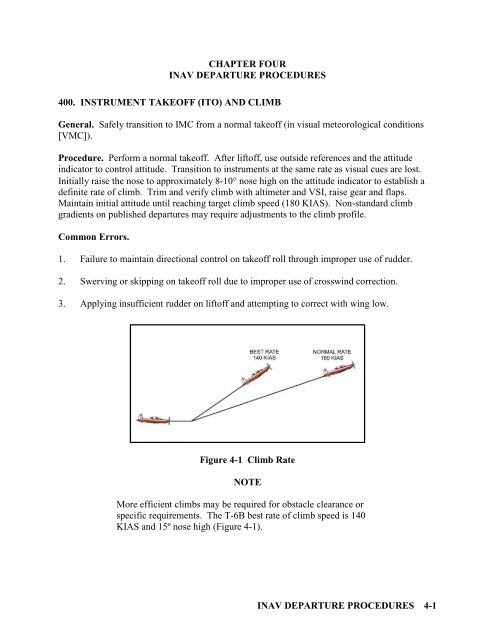Flight Training Instruction - Cnatra - U.S. Navy
Flight Training Instruction - Cnatra - U.S. Navy
Flight Training Instruction - Cnatra - U.S. Navy
You also want an ePaper? Increase the reach of your titles
YUMPU automatically turns print PDFs into web optimized ePapers that Google loves.
CHAPTER FOUR<br />
INAV DEPARTURE PROCEDURES<br />
400. INSTRUMENT TAKEOFF (ITO) AND CLIMB<br />
General. Safely transition to IMC from a normal takeoff (in visual meteorological conditions<br />
[VMC]).<br />
Procedure. Perform a normal takeoff. After liftoff, use outside references and the attitude<br />
indicator to control attitude. Transition to instruments at the same rate as visual cues are lost.<br />
Initially raise the nose to approximately 8-10° nose high on the attitude indicator to establish a<br />
definite rate of climb. Trim and verify climb with altimeter and VSI, raise gear and flaps.<br />
Maintain initial attitude until reaching target climb speed (180 KIAS). Non-standard climb<br />
gradients on published departures may require adjustments to the climb profile.<br />
Common Errors.<br />
1. Failure to maintain directional control on takeoff roll through improper use of rudder.<br />
2. Swerving or skipping on takeoff roll due to improper use of crosswind correction.<br />
3. Applying insufficient rudder on liftoff and attempting to correct with wing low.<br />
Figure 4-1 Climb Rate<br />
NOTE<br />
More efficient climbs may be required for obstacle clearance or<br />
specific requirements. The T-6B best rate of climb speed is 140<br />
KIAS and 15º nose high (Figure 4-1).<br />
INAV DEPARTURE PROCEDURES 4-1
















